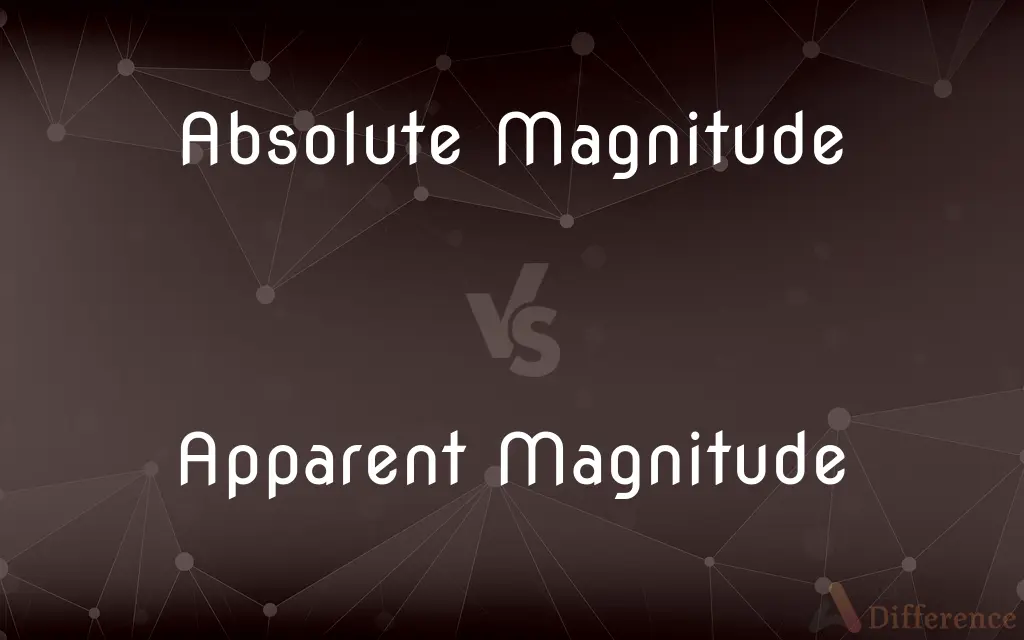Absolute Magnitude vs. Apparent Magnitude — What's the Difference?
By Tayyaba Rehman — Published on November 10, 2023
Absolute Magnitude refers to a star's intrinsic brightness, while Apparent Magnitude denotes its perceived brightness from Earth.

Difference Between Absolute Magnitude and Apparent Magnitude
Table of Contents
ADVERTISEMENT
Key Differences
The cosmos twinkles with myriad stars, their brightness measured using scales like Absolute Magnitude and Apparent Magnitude. Absolute Magnitude provides a measure that delineates the intrinsic or actual brightness of a star, defining its luminosity independently of its distance from the observer. Conversely, Apparent Magnitude encapsulates how bright a star appears to an observer on Earth, thus integrating both the star's inherent luminosity and its distance from the Earth into the measurement, thus maintaining a distinction between Absolute Magnitude and Apparent Magnitude.
A dialogue about stars and their luminosity invariably navigates through discussions of Absolute Magnitude and Apparent Magnitude, crucial concepts in astronomy. When astronomers refer to a star’s Absolute Magnitude, they aim to communicate a standardized brightness, envisioning the star's luminosity if positioned at a canonical distance of 10 parsecs (32.6 light-years) from Earth. The concept of Apparent Magnitude revolves around observational astronomy, factoring in the brightness diminishment due to distance, and hence revealing perceptible brightness, offering a perspective that varies between Absolute Magnitude and Apparent Magnitude.
Navigating through celestial studies, Absolute Magnitude and Apparent Magnitude emerge as pivotal components in understanding stellar and cosmic objects. Absolute Magnitude, unaltered by spatial relationships, allows astronomers to categorize and compare the intrinsic brightness of stars, providing a constant measure unaffected by observational location. Apparent Magnitude, by fluctuating based on the observer’s distance and position, reflects the variable nature of celestial observation, mirroring a dynamic interplay between Absolute Magnitude and Apparent Magnitude.
Drawing upon historical perspectives, Absolute Magnitude and Apparent Magnitude stand as foundational pillars within astronomical measurement systems. Sir Norman Pogson, an astronomer from the 19th century, established the formal logarithmic scale, defining a difference of five magnitudes to equate to a 100-fold change in brightness, creating a scalable system applicable to both Absolute Magnitude and Apparent Magnitude. Consequently, the nuances of stellar observation and characterization were enriched, offering deeper insights and standardization into the luminosities captured by Absolute Magnitude and Apparent Magnitude.
Comparison Chart
Definition
Intrinsic brightness of a star
Perceived brightness from Earth
ADVERTISEMENT
Dependence on Distance
Independent of distance
Directly affected by distance
Use
Comparing actual luminosities of stars
Describing how bright stars appear from Earth
Measurement Standardization
Standardized at 10 parsecs distance
No standard distance
Reflects
Theoretical, intrinsic properties of stars
Practical, observational characteristics
Compare with Definitions
Absolute Magnitude
Celestial Classification Component
The Absolute Magnitude of celestial objects enables structured luminosity comparisons across the universe.
Apparent Magnitude
Viewer-Relative Brightness Metric
To amateur astronomers, a lower Apparent Magnitude translates to a readily visible celestial body.
Absolute Magnitude
Standardized Brightness Metric
Galaxies are categorized based on their Absolute Magnitude, detailing actual luminosity.
Apparent Magnitude
Perceptual Brightness Quantifier
The Apparent Magnitude of Sirius makes it one of the brightest stars in our night sky.
Absolute Magnitude
Constancy Across Observational Location
Despite our vantage point, the Absolute Magnitude of the sun remains consistent.
Apparent Magnitude
Celestial Visibility Indicator
Stars with negative Apparent Magnitude, like Vega, markedly punctuate the celestial panorama observed from Earth.
Absolute Magnitude
Intrinsic Luminosity Descriptor
The star’s Absolute Magnitude of -4 indicates high intrinsic brightness.
Apparent Magnitude
Observational Luminosity Gauge
Varying distances from Earth impact the Apparent Magnitude of stars, altering perceived brightness.
Absolute Magnitude
Independent Luminosity Measure
Utilizing Absolute Magnitude, astronomers discern core stellar brightness, excluding distance factors.
Apparent Magnitude
Distance-Influenced Luminosity Measure
The star’s luminescence, as measured by its Apparent Magnitude, dimmed due to increased observer distance.
Common Curiosities
What is a notably bright Apparent Magnitude?
A notably bright Apparent Magnitude would be a negative value, such as -1.46 for Sirius.
How is Apparent Magnitude influenced by distance?
Apparent Magnitude reflects perceived brightness, thus diminishing with increased distance.
What does Absolute Magnitude measure?
Absolute Magnitude measures the intrinsic brightness of a star.
Does Absolute Magnitude change with observer location?
No, Absolute Magnitude remains constant regardless of observer location.
How is Absolute Magnitude standardized?
Absolute Magnitude is standardized by measuring brightness as if the star were 10 parsecs away.
Is Apparent Magnitude absolute or relative?
Apparent Magnitude is relative to the observer’s distance and position.
What purpose does Absolute Magnitude serve in astronomy?
Absolute Magnitude allows astronomers to categorize and compare the actual luminosities of stars.
Can Apparent Magnitude values be negative?
Yes, Apparent Magnitude can be negative, indicating high brightness.
What’s the relationship between Absolute Magnitude and luminosity?
Absolute Magnitude directly reflects a star's intrinsic luminosity.
Is there a maximum value for Absolute Magnitude?
No defined maximum; however, the Absolute Magnitude of extremely bright objects is negative.
How are Absolute Magnitude and Apparent Magnitude related?
Both magnitudes measure brightness but Absolute Magnitude is intrinsic, while Apparent is observer-dependent.
Can Absolute Magnitude be utilized for galaxies?
Yes, Absolute Magnitude can be used to categorize the intrinsic brightness of galaxies.
How does Earth’s atmosphere impact Apparent Magnitude?
Earth’s atmosphere can diminish Apparent Magnitude, making stars appear dimmer.
Does Apparent Magnitude quantify actual star brightness?
No, Apparent Magnitude quantifies perceived brightness from Earth, influenced by distance.
Does a star’s Absolute Magnitude affect its lifecycle?
Absolute Magnitude does not affect a star’s lifecycle, though it provides insights into its stage and structure.
Share Your Discovery

Previous Comparison
Absorption Spectrum vs. Emission Spectrum
Next Comparison
Java vs. JavawAuthor Spotlight
Written by
Tayyaba RehmanTayyaba Rehman is a distinguished writer, currently serving as a primary contributor to askdifference.com. As a researcher in semantics and etymology, Tayyaba's passion for the complexity of languages and their distinctions has found a perfect home on the platform. Tayyaba delves into the intricacies of language, distinguishing between commonly confused words and phrases, thereby providing clarity for readers worldwide.











































